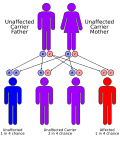Cystinosis
(Redirected from Cystine storage disease)
Editor-In-Chief: Prab R Tumpati, MD
Obesity, Sleep & Internal medicine
Founder, WikiMD Wellnesspedia &
W8MD medical weight loss NYC and sleep center NYC
| Cystinosis | |
|---|---|

| |
| Synonyms | N/A |
| Pronounce | N/A |
| Specialty | N/A |
| Symptoms | Fanconi syndrome, growth retardation, photophobia, renal failure |
| Complications | Kidney failure, hypothyroidism, diabetes mellitus, muscle wasting |
| Onset | Infancy |
| Duration | Lifelong |
| Types | Nephropathic cystinosis, Intermediate cystinosis, Ocular cystinosis |
| Causes | Mutations in the CTNS gene |
| Risks | Autosomal recessive inheritance |
| Diagnosis | Genetic testing, corneal cystine crystal examination |
| Differential diagnosis | Fanconi syndrome, cystinuria, other metabolic disorders |
| Prevention | N/A |
| Treatment | Cysteamine, kidney transplantation, symptomatic treatment |
| Medication | Cysteamine |
| Prognosis | Variable, depends on treatment |
| Frequency | 1 in 100,000 to 200,000 live births |
| Deaths | N/A |
Cystinosis
Cystinosis is a rare, inherited metabolic disorder characterized by the accumulation of the amino acid cystine within lysosomes, leading to cellular damage. This condition primarily affects the kidneys and eyes, but can also impact other organs and tissues.
Pathophysiology
Cystinosis is caused by mutations in the CTNS gene, which encodes the protein cystinosin. Cystinosin is responsible for transporting cystine out of lysosomes. When this transport is impaired, cystine accumulates, forming crystals that can cause cellular dysfunction and damage.
Types of Cystinosis
Cystinosis is classified into three main types based on the age of onset and severity of symptoms:
Nephropathic Cystinosis
This is the most common and severe form, typically presenting in infancy. It is characterized by renal tubular Fanconi syndrome, leading to excessive loss of water, sodium, potassium, and other substances in the urine.
Intermediate Cystinosis
Also known as juvenile or adolescent cystinosis, this form presents later in childhood or adolescence. It is less severe than nephropathic cystinosis but can still lead to significant kidney damage over time.
Ocular Cystinosis
This form primarily affects the eyes, causing photophobia and corneal crystal deposits. It usually presents in adulthood and does not typically involve kidney dysfunction.
Clinical Manifestations
Renal Symptoms
- Fanconi Syndrome: Characterized by polyuria, polydipsia, and growth retardation due to renal tubular dysfunction. - Chronic Kidney Disease: Progressive renal impairment leading to end-stage renal disease if untreated.
Ocular Symptoms
- Photophobia: Sensitivity to light due to corneal cystine crystal deposits. - Corneal Crystals: Visible deposits in the cornea that can be detected by slit-lamp examination.
Other Symptoms
- Hypothyroidism: Due to cystine accumulation in the thyroid gland. - Diabetes Mellitus: Resulting from pancreatic involvement. - Muscle Weakness: Due to cystine accumulation in muscle tissue.
Diagnosis
Diagnosis of cystinosis is based on clinical presentation, family history, and laboratory tests. Measurement of cystine levels in leukocytes is a key diagnostic test. Genetic testing can confirm mutations in the CTNS gene.
Treatment
Cysteamine Therapy
Cysteamine is the primary treatment for cystinosis. It reduces cystine accumulation by converting cystine into cysteine and cysteine-cysteamine mixed disulfide, which can exit the lysosome.
Supportive Care
- Renal Replacement Therapy: Dialysis or kidney transplantation for end-stage renal disease. - Electrolyte Replacement: To manage Fanconi syndrome. - Ocular Drops: Cysteamine eye drops to reduce corneal crystal deposits.
Prognosis
With early diagnosis and treatment, individuals with cystinosis can have improved outcomes. However, untreated cystinosis can lead to significant morbidity and mortality due to renal failure and other complications.
Gallery
See Also
- Lysosomal storage disease - Fanconi syndrome - End-stage renal disease
Transform your life with W8MD's budget GLP-1 injections from $125.
W8MD offers a medical weight loss program to lose weight in Philadelphia. Our physician-supervised medical weight loss provides:
- Most insurances accepted or discounted self-pay rates. We will obtain insurance prior authorizations if needed.
- Generic GLP1 weight loss injections from $125 for the starting dose.
- Also offer prescription weight loss medications including Phentermine, Qsymia, Diethylpropion, Contrave etc.
NYC weight loss doctor appointments
Start your NYC weight loss journey today at our NYC medical weight loss and Philadelphia medical weight loss clinics.
- Call 718-946-5500 to lose weight in NYC or for medical weight loss in Philadelphia 215-676-2334.
- Tags:NYC medical weight loss, Philadelphia lose weight Zepbound NYC, Budget GLP1 weight loss injections, Wegovy Philadelphia, Wegovy NYC, Philadelphia medical weight loss, Brookly weight loss and Wegovy NYC
|
WikiMD's Wellness Encyclopedia |
| Let Food Be Thy Medicine Medicine Thy Food - Hippocrates |
Medical Disclaimer: WikiMD is not a substitute for professional medical advice. The information on WikiMD is provided as an information resource only, may be incorrect, outdated or misleading, and is not to be used or relied on for any diagnostic or treatment purposes. Please consult your health care provider before making any healthcare decisions or for guidance about a specific medical condition. WikiMD expressly disclaims responsibility, and shall have no liability, for any damages, loss, injury, or liability whatsoever suffered as a result of your reliance on the information contained in this site. By visiting this site you agree to the foregoing terms and conditions, which may from time to time be changed or supplemented by WikiMD. If you do not agree to the foregoing terms and conditions, you should not enter or use this site. See full disclaimer.
Credits:Most images are courtesy of Wikimedia commons, and templates, categories Wikipedia, licensed under CC BY SA or similar.
Contributors: Prab R. Tumpati, MD



